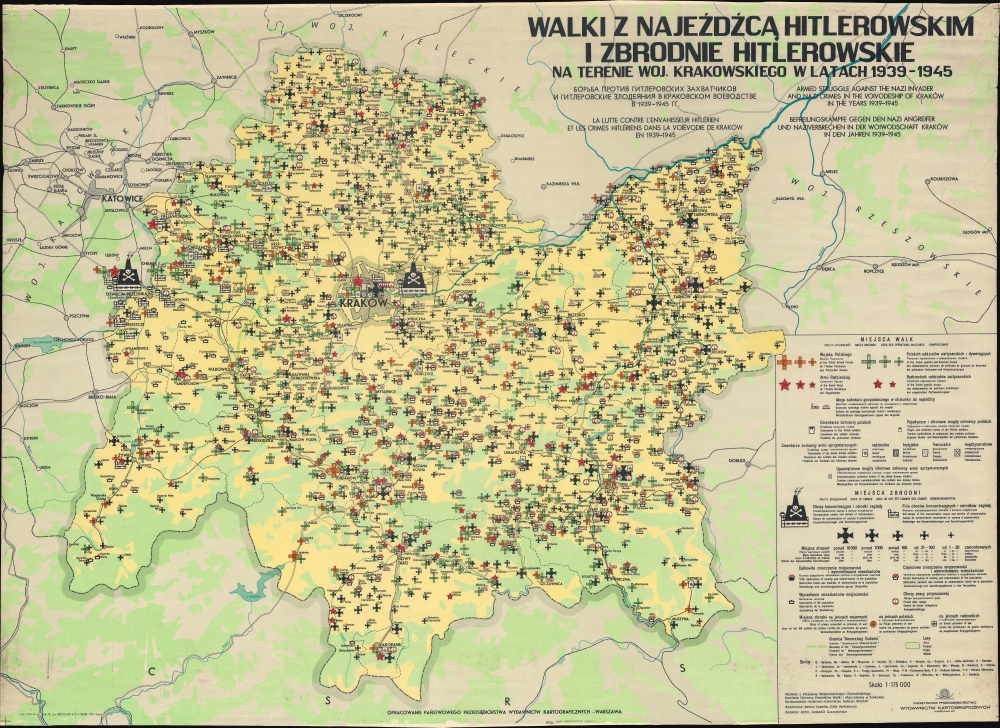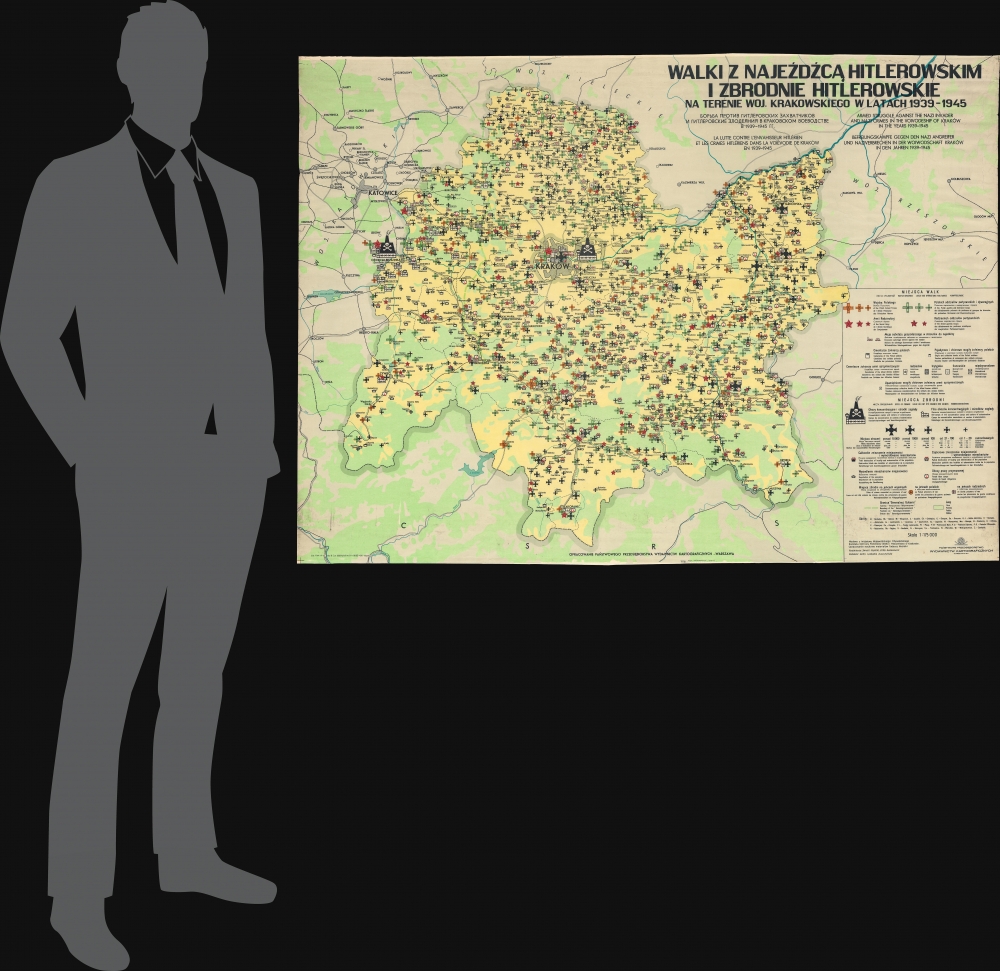1971 Polish Multilingual Map of Nazi Crimes in the Voivodeship of Krakow
WojKrakowskiego-ochrony-1971$4,000.00

Title
Walki Z Najeźdźcą Hitlerowskim I Zbrodnie Hitlerowskie na Terenie Woj. Krakowskiego w Latach 1929-1945. / Armed Struggle Against the Nazi Invader and Nazi Crimes in the Voivodeship of Kraków in the Years 1939 - 1945.
1971 (dated) 37.75 x 52 in (95.885 x 132.08 cm) 1 : 175000
1971 (dated) 37.75 x 52 in (95.885 x 132.08 cm) 1 : 175000
Description
A chilling 1971 wall map detailing Hitler's war crimes and the fight against the invasion and occupation in the voivodeship of Krakow. It was published by Krakow's Provincial Citizens' Committee for the Protection of Monuments of Struggle and Martyrdom. It is ever more poignant in the light of modern revisionist historical research that has re-evaluated the Polish role in the Holocaust, as well as efforts by the current Polish government to legislate and control the historical record. All text on this piece is in Polish, English, French, and German.
This derives from the necessity of kowtowing to Soviet censorship. Although the Nazis and Hitler specifically are demonized, there is no clear anti-German bias. The map appears to have been produced from impartial sources to represent Nazi war crimes accurately. Through this and similar maps, much of the current leadership of Poland, who grew up in the Soviet Era, received their education and understanding of the Holocaust.
Today, historical revisionism regarding Poland's role in the Holocaust encompasses a contentious area of public discourse. The narrative traditionally highlights Poland as a nation under German occupation, with Poles risking their lives to help Jews. This happened. However, current scholars are bringing to light instances where some Poles collaborated with Nazis or participated in the persecution of Jews. This revisionism has sparked intense debate, influenced by broader considerations of national identity, memory, and responsibility. Current efforts by the Polish government to legislate how the Holocaust is remembered, particularly laws making it illegal to accuse the Polish nation of complicity in the Holocaust, have further intensified these debates, highlighting the ongoing struggle over the historical memory.
Emphasizing Nazi Crimes
The map depicts the entire voivodeship of Krakow along with the immediate surroundings. Icons detail Nazi crimes. The two largest mark Oświęcim-Brzezinka (Auschwitz-Birkenau), the notorious extermination camp just outside the voivodeship, and Płaszów, the concentration camp established on the outskirts of Krakow. Other icons surrounding Auschwitz highlight the fact that Auschwitz wasn't just one camp but also a whole network of subcamps. Black German iron crosses mark mass execution sites, and the size of the cross corresponds to the magnitude of the massacre. The largest crosses, such as those in Krakow, Tarnów, and Nowy Sacz, symbolize massacres of over 10,000 individuals. Corresponding symbols mark towns that were totally destroyed, and their entire population was exterminated, towns that were partially destroyed and exterminated, and towns where the population was deported. Small red shovels surrounded by barbed wire identify locations of forced labor camps. Symbols also mark sites of crimes committed against Polish and Soviet Prisoners of War.Fighting the Invasion and Occupation
The other symbols present highlight actions taken against the Nazis. Orange crosses mark the battlegrounds of the Polish Armed Forces, while green crosses mark the battle sites of Polish guerrilla forces. Red stars mark Red Army and Soviet guerrilla battle sites. Small symbols with red 'x's through them highlight locations of sabotage actions taken against the Nazis. Other symbols mark cemeteries and graves for Polish, Soviet, British, French, and International forces buried in Poland.Through a Soviet Lens
When this map was issued, Poland was firmly part of the Soviet Eastern Bloc. While the map is sensitive to the plight of Poles in general and especially the Soviets who suffered under the Nazis, this map is representative of the Soviet party line regarding 'Hitler's atrocities' - that all nations suffered, fought, and won equally. Aside from the Soviets and Poles, there is no mention of any specific ethnic or religious group. There also is naturally no mention of the Soviet Union's repressive actions and war crimes against Poles.This derives from the necessity of kowtowing to Soviet censorship. Although the Nazis and Hitler specifically are demonized, there is no clear anti-German bias. The map appears to have been produced from impartial sources to represent Nazi war crimes accurately. Through this and similar maps, much of the current leadership of Poland, who grew up in the Soviet Era, received their education and understanding of the Holocaust.
Today, historical revisionism regarding Poland's role in the Holocaust encompasses a contentious area of public discourse. The narrative traditionally highlights Poland as a nation under German occupation, with Poles risking their lives to help Jews. This happened. However, current scholars are bringing to light instances where some Poles collaborated with Nazis or participated in the persecution of Jews. This revisionism has sparked intense debate, influenced by broader considerations of national identity, memory, and responsibility. Current efforts by the Polish government to legislate how the Holocaust is remembered, particularly laws making it illegal to accuse the Polish nation of complicity in the Holocaust, have further intensified these debates, highlighting the ongoing struggle over the historical memory.
Publication History and Census
Tadeusz Wroński undertook the scientific preparation of material for the composition of this piece; it was edited by Janusz Łopatto, Zofia Awłasewicz, and Leokadia Juszdzńska, and published on the initiative of the Provincial Citizens' Committee for the Protection of Monuments of Struggle and Martyrdom in Krakow (Wojewódzkiego Obywatelskiego Komitetu Ochrony Pomników Walki i Męczeństwa w Krakowie) and the National Cartographic Publishing Company (Państwowe Przedsiębiorstwo Wydawnictw Kartograficznych). We note 7 examples cataloged in OCLC, which are part of the collections at Yale University, the Library of Congress, the University of Illinois at Urbana Champaign, the Herder-Institut, the Union Catalog of Polish Research Libraries, and the National Library of Poland.Condition
Very good. Mounted on original linen. Wear to edges. Small closed edge tears.
References
OCLC 5406214.




